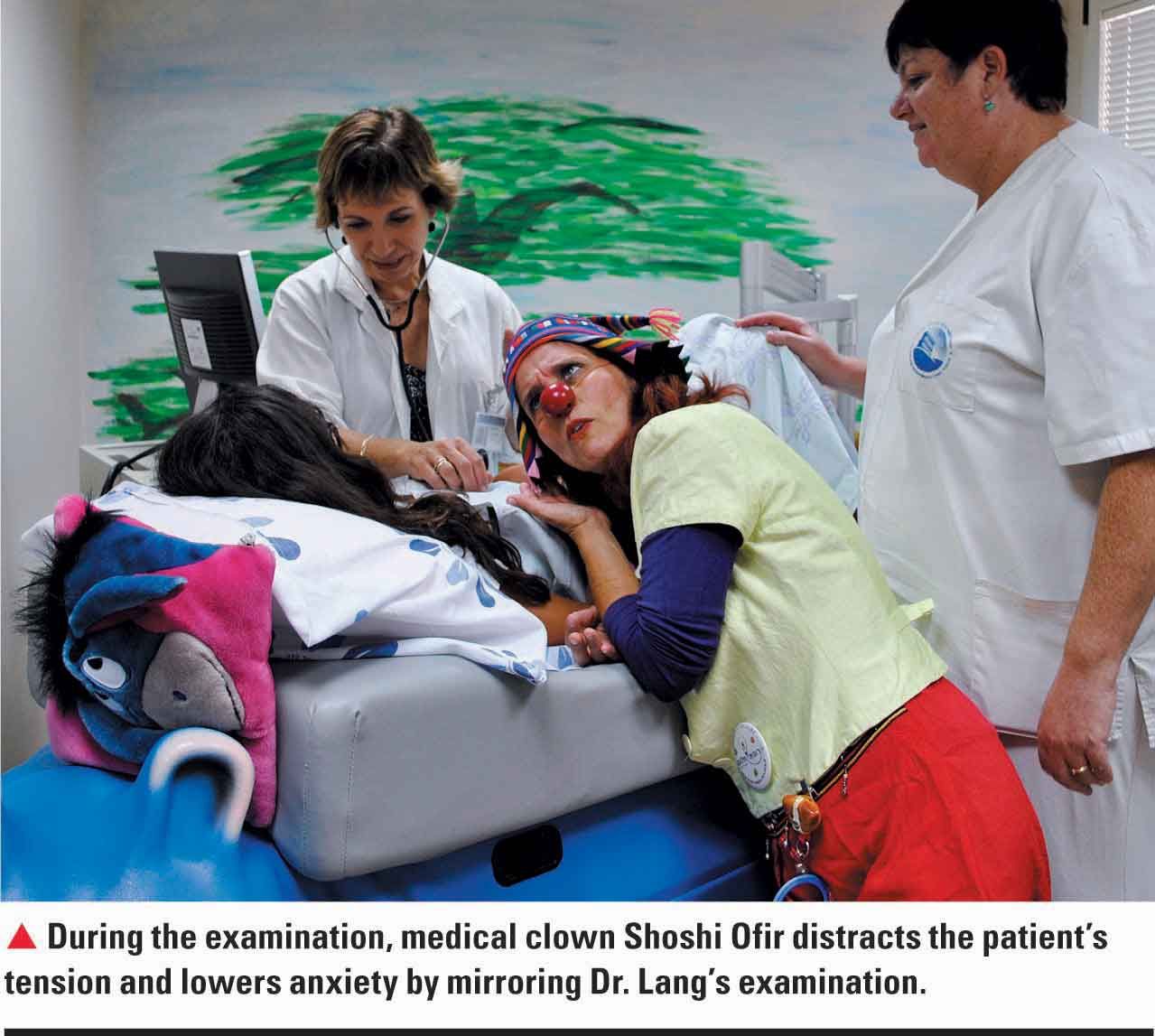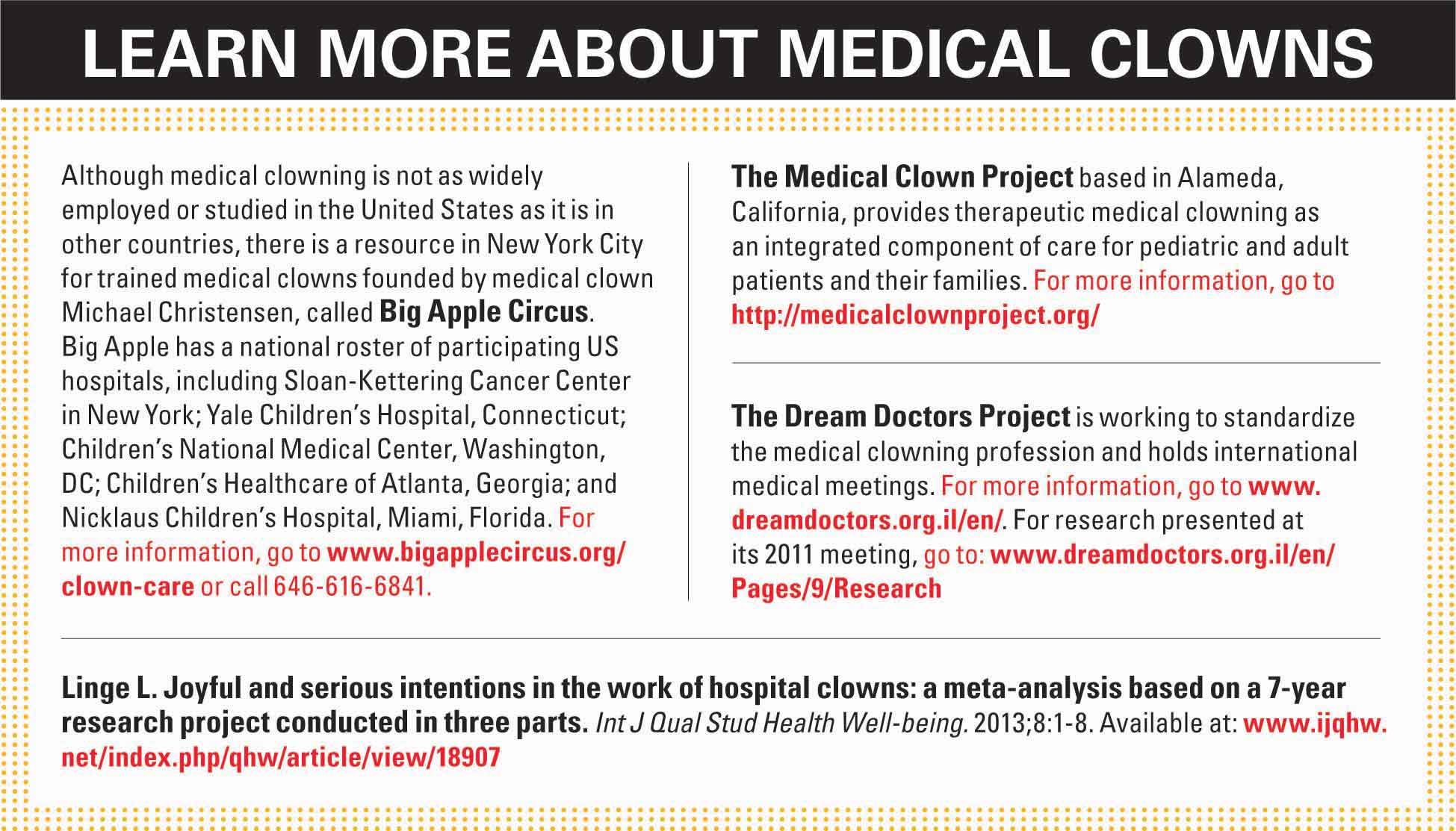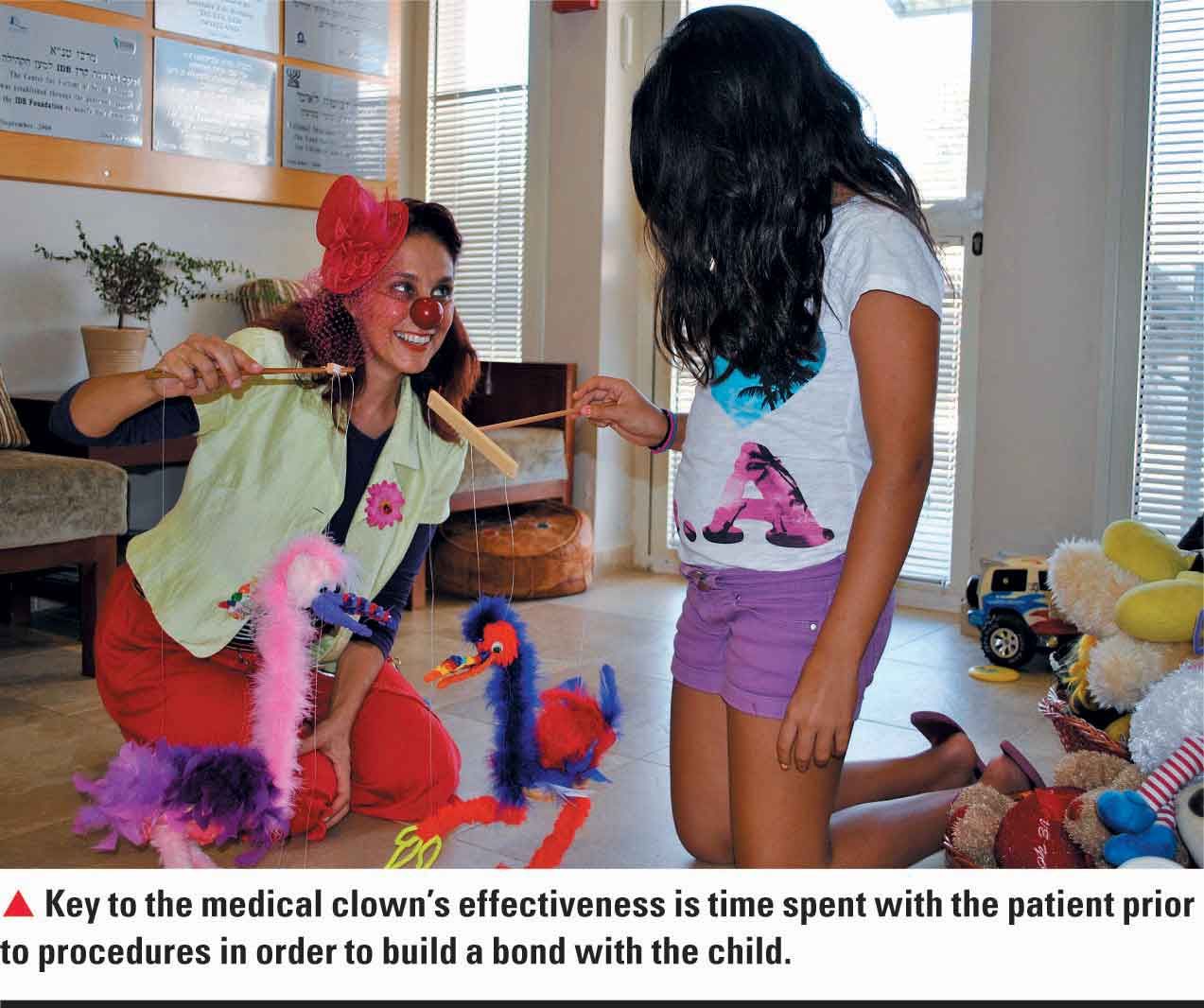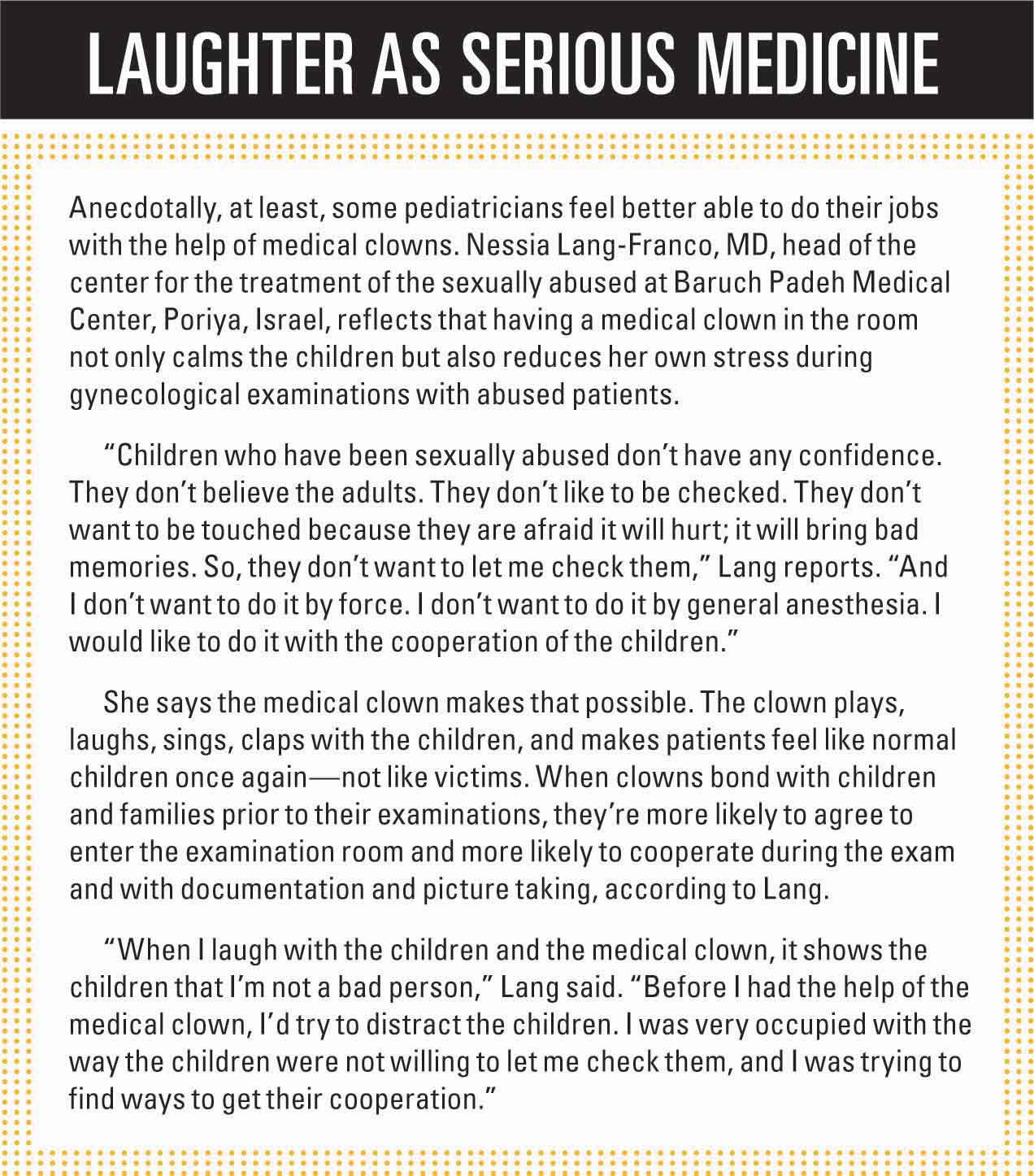Medical clowning
Medical clowning has a growing base of evidence giving credibility to its effectiveness with both pediatric and adult patients. In addition some physicians report anecdotally that having a medical clown participate in a child’s care helps everyone involved-from patients and parents to staff.
Medical clowning has a growing base of evidence giving credibility to its effectiveness with both pediatric and adult patients. In addition some physicians report anecdotally that having a medical clown participate in a child’s care helps everyone involved-from patients and parents to staff.

Children and families who enter the hospital full of fear, sadness, and sometimes shame, change when they see the clown, according to Nessia Lang-Franco, MD, head of the center for the treatment of the sexually abused at Baruch Padeh Medical Center, Poriya, Israel.
More: Calming hospital anxieties
“The clown welcomes the child and makes him feel important,” Dr Lang explains. “When he enters the examination room, he feels stronger and more confident. He’s not so afraid.”
Medical clowning combines the art of clowning with selective medical and psychological training. These individuals are considered paramedical professionals who work alongside doctors, nurses and other healthcare providers, according to an informational video on medical clowning created by the Dream Doctors Project, an Israeli group of about 100 medical clowns, who work at some 30 hospitals in the country.1
It’s no joke
This is not like a circus act; there is no script or template, according to Shoshi Ofir, MA, University of Haifa. Ofir, a medical clown and member of the Dream Doctors Project, works at 2 hospitals in Israel: The Baruch Padeh Medical Center, Poriya, and the Rivka Ziv Medical Center, Safed.
“[We medical clowns] have had previous experience and, or, studies in theater, clowning, puppetry, or circus,” Ofir states. “However we also learn a lot about the hospital. We learn how to help the health process. We call it clowns at the service of medicine.”
Although there are not yet standard credentials established for medical clowning, Ofir holds a bachelor’s of arts degree in medical clowning, a course of study that combined courses in both nursing and theater. She then earned a master’s in art therapy, a degree that focused intensively on psychology.
Effective medical clowns, she states, must be versant in psychology and gifted with empathy.
“We are with people in situations which are not comfortable…. It’s a stressful situation-[often] a crisis situation. We have 1000 antennas, feeling out what’s happening: How close I can get? How loud I can be? How surprising can I be? Do I need to be silent? Or make a big fuss? What can I say? What shouldn’t I say? What is correct and exact for this specific situation? What is needed from me?” Ofir catalogs.
NEXT: Where the medical clown goes
Ofir said she and other medical clowns serve as the children’s allies. She’ll accompany children before, during and after procedures, including blood taking, to examinations, and to surgery.
“I walk with them and get them ready for their procedures,” Ofir reports. “I have a little oxygen mask and a syringe without the needle. I have some of the equipment with me, and we play with it. Then they go into the pre-op room, and I’m there with them. When it’s needed, I accompany them until they are asleep. And the moment they wake up, I’m there.”
Ofir, who is also trained to read vital signs, also works in the neonatal unit, where she’ll nurture the babies and parents, often helping the parents hold, talk to, and sing to their children. Ofir learned how to work in this unit from Blandine Thévenon and Grégoire Rey, 2 medical clowns from the "Doctor Clown" group located in Lyon, France.

“Parents [in the neonatal unit] don’t do what parents usually do. Some of them don’t pick up the child, and sing to the child…. [Many] are in shock most of the time,” Ofir observes. “So, what I do is I sing to the babies, and I talk to them.”
Even a medical clown’s appearance should be well thought out, according to Ofir, who wears unusual clothes, silly hats, and a red clown’s nose-but no white makeup.
Recommended: New model for hospital-based pediatric care
“When they look at me, children see a person. The makeup of a clown is good for parades or big parties, but it’s not good for 1 or 3 feet away from a person,” Ofir explains. “It’s too much.”
It’s critical that the clowns be acutely in tune with the medical team, she stresses.
“I know the process. I know when I can talk and lead the situation and when I [must] step back and let them (the medical staff) lead. I’m there to help this procedure happen. I’m not there to play an actress,” Ofir says.
Not surprisingly, medical clowning is most successful when clown and doctor have a good working relationship, Lang notes. Ideally, the care atmosphere fostered is one in which physicians feel open-minded and willing to get in on the fun by laughing, singing, or being part of a game or jokes.
This requisite “buy in” is reflected in a recent study on the use of medical clowns in the pediatric intensive care unit (PICU) that recommended that PICU teams understand, accept, and support the clowns’ work before medical clowns become part of the units.2
NEXT: Science of medical clowning
The science of medical clowning
Medical clowning can be therapeutic for patients and their families, according to some studies.
Lang and Ofir were among the authors on a recent paper in which researchers surveyed 9 children who underwent invasive examinations and their accompanying parents at a hospital in Israel on their experiences.
“The interviews revealed that the medical clowning intervention during invasive examinations was essentially therapeutic, with the clown using theatrical and clowning tools to incorporate therapeutic elements such as empowerment, reversal of role, reframing, and building a therapeutic alliance. In addition, during the invasive examinations, the medical clowning followed the model of crisis brief intervention therapy,” states the 2015 study published in Clinical Pediatrics.3
The research also helped to confirm that it’s important for the clown to be with the child as a prelude to an examination or procedure in order to create a bond and trust, rather than greeting the child exactly when the procedure or exam begins.
More: Tackling BPD-associated hospitalizations
“When they have a bond with me, and I’m with them, and we go into the examination, they feel safe,” Ofir reports. “They’re smiling.”
Ofir says they also found in the surveys that children tend to remember the clown first and foremost after leaving the hospital.

The researchers say their findings help confirm the benefit of incorporating medical clowns as integral members of hospital-based pediatric medical teams.
Mitigating re-trauma
The use of medical clowns can be particularly beneficial for children already traumatized by sexual or physical abuse. In 3 cases looking at the involvement of a medical clown during examinations with sexually abused children, Lang and colleagues reported that “…medical clowns play a unique role both in lowering anxiety and fear among children before and during the unpleasant forensic examination, as well as in mitigating potential re-traumatization of the sexual abuse event resulting from the medical examination. The medical clown was found to assist in creating a pleasant and calm atmosphere, thus improving the child's cooperation during the examination.”4
“Generally, when I have the help of the medical clown, I don’t use any anesthesia [during examinations],” Lang states. This, the doctor says, lowers healthcare costs and increases value by eliminating the need not only for the drugs, but for the anesthetist as well as and the time required for the child’s recovery from the anesthetic. As a result, the children experience less pain and trauma.
In an earlier study published in 2009, researchers reported that the presence of medical clowns lowered preoperative anxiety levels among children undergoing elective outpatient surgery and receiving general anesthesia, compared to children who didn’t have medical clowns and another group that received oral midazolam 30 minutes before surgery.
“The clowns' effect on anxiety reduction continued when the children entered the operating room but was equal at this point to the midazolam group. Upon application of the anesthesia mask, no significant differences were detected between the groups,” stated the study.5
Researchers in Israel studied the use of medical clowns for pediatric idiopathic arthritis patients undergoing nitrous oxide sedation during intra-articular corticosteroid injection. They, too, found positive results in their study of 32 children and now consider the clowns an integral part of the team performing intra-articular corticosteroid injections.
According to the study, “Active participation of a medical clown during intra-articular corticosteroid injection with nitrous oxide for juvenile idiopathic arthritis further decreases pain and stress and results in a positive patient experience.”6
Medical clowns also appear to have had a positive impact on patients in some intensive care units. Researchers reported for the first time on the use of medical clowns in a PICU in July 2015. Clowns were active in half of the 32 PICUs (including neonatal intensive care units) that responded to a survey. The results found that unit head doctors were satisfied or very satisfied in 92.3% of the cases which involved participation by the medical clowns.
The clowns, the researchers concluded, appear a common and worthwhile practice, despite the severity of situations in the PICU, according to the study.2
NEXT: Relieving anxiety for tests
Researchers have also reported the clowns help relieve children’s anxiety and perceived pain while having allergy skin prick tests and intravenous catheter insertion during emergency department visits.7,8
Yet another study supporting increased use of medical clowns in pediatric hospitals looked at how pediatric clowning is utilized in Germany and documented evaluations of hospital clowns, parents, and hospital staff.

“The online survey showed that the hospital clowns are well-trained, motivated, and generally satisfied with their work. By their own estimate, they primarily boost morale and promote imagination in the patients,” reported the study. “According to the data, a clown intervention boosts morale and reduces stress in the patients. Moreover, there are practically no side effects. Both parents and hospital staff stated that the patients, as well as they themselves, benefited from the intervention.”9
Next: Teaching kids to cope with stress
By inspiring relief from the anxiety of the hospital and the stressors of some clinical procedures, for children, parents, and staff, pediatric clowns prove that laughter can serve as a force multiplier in the promotion of trust and healing.
References
1. The Dream Doctors Project- Israeli Medical Clowns. YouTube. Uploaded July 29, 2010. [https://www.youtube.com/watch?v=-eVHoDnKy0Q]
2. Mortamet G, Simonds C, Hattab A, Delpy S, Hubert P, Dupic L. [Clowns in the pediatric intensive care unit in France]. Arch Pediatr. 2015;22(7):718-23.
Ofir S, Tener D, Lev-wiesel R, On A, Lang-franco N. The Therapy Beneath the Fun: Medical Clowning During Invasive Examinations on Children. Clin Pediatr (Phila). 2015.
Tener D, Lev-wiesel R, Franco NL, Ofir S. Laughing through this pain: medical clowning during examination of sexually abused children: an innovative approach. JChild Sex Abus. 2010;19(2):128-40.
Golan G, Tighe P, Dobija N, Perel A, Keidan I. Clowns for the prevention of preoperative anxiety in children: a randomized controlled trial. Paediatr Anaesth. 2009;19(3):262-6.
Weintraub Y, Rabinowicz N, Hanuka P, Rothschild M, Kotzki S, Uziel Y. Medical clowns facilitate nitrous oxide sedation during intra-articular corticosteroid injection for juvenile idiopathic arthritis. Isr Med Assoc J. 2014;16(12):771-3.
7. Goldberg A, Stauber T, Peleg O, Hanuka P, Eshayek L, Confino-cohen R. Medical clowns ease anxiety and pain perceived by children undergoing allergy prick skin tests. Allergy. 2014;69(10):1372-9.
8. Wolyniez I, Rimon A, Scolnik D, et al. The effect of a medical clown on pain during intravenous access in the pediatric emergency department: a randomized prospective pilot study. Clin Pediatr (Phila). 2013;52(12):1168-72.
9. Barkmann C, Siem AK, Wessolowski N, Schulte-markwort M. Clowning as a supportive measure in paediatrics - a survey of clowns, parents and nursing staff. BMC Pediatr. 2013;13:166.
Newsletter
Access practical, evidence-based guidance to support better care for our youngest patients. Join our email list for the latest clinical updates.